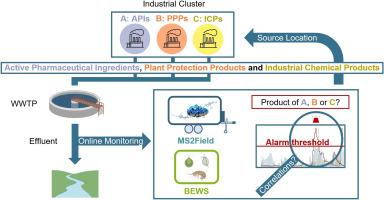工业废水的先进现场监测:在线生物和化学工具的集成,以识别有毒化合物
IF 12.4
1区 环境科学与生态学
Q1 ENGINEERING, ENVIRONMENTAL
引用次数: 0
摘要
对复杂工业集群的污水处理厂(WWTP)出水进行高时间分辨率监测对于检测和随后管理有问题的化合物以减少其释放到环境中至关重要。本研究探索了将生物预警系统(BEWS)与可移动的高效液相色谱-电喷雾电离和高分辨率串联质谱(HPLC-ESI-HRMS/MS)平台(MS2Field)结合起来检测和识别工业污水处理厂废水中有毒污染物的潜力。BEWS利用水蚤、小球藻和Gammarus pulex等生物提供了对微污染物的实时生物响应,而MS2Field则可以并行进行有毒化合物的连续化学检测。在两个月的监测期间,观察到BEWS生物的行为变化与污水处理厂废水中工业目标物质和非目标物质的存在之间存在显著的相关性。生物和化学时间序列的平行测量和相关性揭示了四个毒性事件,并确定了与这些毒性峰值相关的八种已知和未知化合物或化合物类别。结合来自工业生产现场的信息,这种综合方法使工业排放的战略性源头追踪成为可能。当将在线监测工具的数据与实验室生物测定和复合样品的化学分析结果进行比较时,很明显,高时间分辨率测量是准确指示毒性趋势的关键。否则,在储存过程中,污染物的峰值部分被稀释或降解所掩盖。该方法为寻求实施更有效和可持续的污染管理战略的行业和监管机构提供了污染源的可追溯性。本文章由计算机程序翻译,如有差异,请以英文原文为准。

Advanced On-Site Monitoring of Industrial Wastewater: Integration of Online Biological and Chemical Tools to Identify Toxic Compounds
Monitoring of wastewater treatment plant (WWTP) effluents from complex industrial clusters with high temporal resolution is crucial for detecting and subsequently managing problematic compounds to reduce their release into the environment. This study explored the potential of combining biological early warning systems (BEWS) with a transportable high-performance liquid chromatography coupled with electrospray ionization and high-resolution tandem mass spectrometry (HPLC-ESI-HRMS/MS) platform (MS2Field) to detect and identify toxic pollutants in industrial-driven WWTP effluent. BEWS, using the organisms Daphnia magna, Chlorella vulgaris, and Gammarus pulex, provided real-time biological responses to micropollutants, while the MS2Field allowed continuous chemical detection of toxic compounds in parallel. Over a two-month monitoring period, significant correlations were observed between behavioural changes in the BEWS organisms and the presence of industrial target and non-target substances in the WWTP effluent. The parallel measurement and correlation of biological and chemical time series revealed four toxicity events and identified eight known and unknown compounds or compound classes associated with these toxicity peaks. Together with information from the industrial production site, this integrated approach enabled strategic source tracing of industrial emissions. When comparing data from the online monitoring tools with results from laboratory bioassays and chemical analysis of composite samples, it became obvious that high temporal resolution measurements are the key to accurately indicate toxicity trends. Otherwise, contaminant peaks were partially masked by dilution or degradation during storage. The approach offers traceability of sources for industries and regulators seeking to implement more effective and sustainable pollution management strategies.
求助全文
通过发布文献求助,成功后即可免费获取论文全文。
去求助
来源期刊

Water Research
环境科学-工程:环境
CiteScore
20.80
自引率
9.40%
发文量
1307
审稿时长
38 days
期刊介绍:
Water Research, along with its open access companion journal Water Research X, serves as a platform for publishing original research papers covering various aspects of the science and technology related to the anthropogenic water cycle, water quality, and its management worldwide. The audience targeted by the journal comprises biologists, chemical engineers, chemists, civil engineers, environmental engineers, limnologists, and microbiologists. The scope of the journal include:
•Treatment processes for water and wastewaters (municipal, agricultural, industrial, and on-site treatment), including resource recovery and residuals management;
•Urban hydrology including sewer systems, stormwater management, and green infrastructure;
•Drinking water treatment and distribution;
•Potable and non-potable water reuse;
•Sanitation, public health, and risk assessment;
•Anaerobic digestion, solid and hazardous waste management, including source characterization and the effects and control of leachates and gaseous emissions;
•Contaminants (chemical, microbial, anthropogenic particles such as nanoparticles or microplastics) and related water quality sensing, monitoring, fate, and assessment;
•Anthropogenic impacts on inland, tidal, coastal and urban waters, focusing on surface and ground waters, and point and non-point sources of pollution;
•Environmental restoration, linked to surface water, groundwater and groundwater remediation;
•Analysis of the interfaces between sediments and water, and between water and atmosphere, focusing specifically on anthropogenic impacts;
•Mathematical modelling, systems analysis, machine learning, and beneficial use of big data related to the anthropogenic water cycle;
•Socio-economic, policy, and regulations studies.
 求助内容:
求助内容: 应助结果提醒方式:
应助结果提醒方式:


